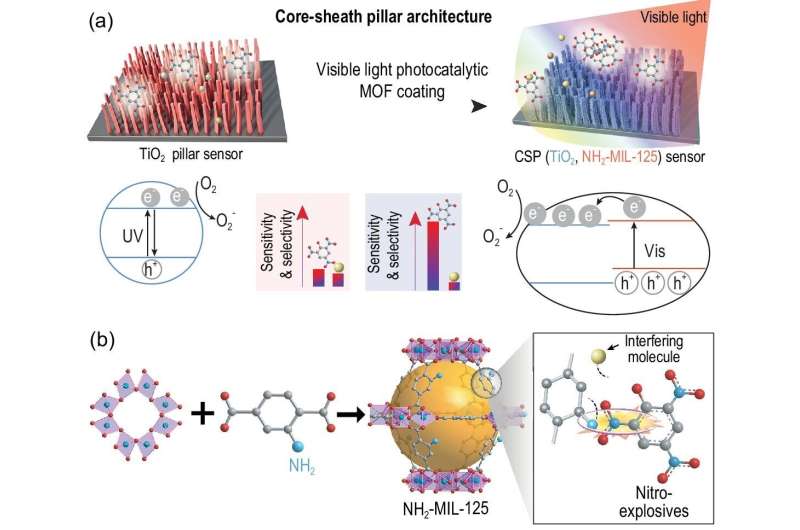Nitro-explosives detection realized by core-sheath pillar architecture

To create an artificial structure that surpasses the sensitivity, selectivity, and speed of the olfaction system of animals is a challenge.
In a study published in National Science Review, researchers at Fujian Institute of Research on the Structure of Matter of the Chinese Academy of Sciences, Beijing Institute of Technology and Kyoto University presented a new paradigm of a core-sheath pillar (CSP) architecture with a perfect synergistic interface that effectively integrates the advantages of metal organic frameworks (MOFs) and metal oxides (MOs) to tackle the above-mentioned challenge.
The researchers coated NH2-MIL-125, crystalline microporous material with a high affinity to analytes, on the surface of TiO2 nanowires with a corndog-like core-sheath pillar (CSP) architecture. NH2-MIL-125 adsorbs selectively and locally concentrates target molecules, while TiO2 provides the active sites for the sensing reaction and conducts the electrical sensing signal.
The essential question of CSP (MO, MOF) is how to create a perfect energy-band-matched MOF/MO interface that can effectively generate and separate light-excited charge carriers to produce active oxygen species.
The researchers developed a two-step seed-assisted solvothermal method to fabricate this type of CSP architecture, the desired visible-light-active and analyte-accessible MOF/MO interface was achieved by NH2-MIL-125 coupled with TiO2. They not only revealed the novel structure of CSP TiO2, NH2-MIL-125), but also solved fundamental scientific issue in sensing community. It is for the first time that oriented MOF material can be grown on to nanostructured material to realize aligned microchannels.
The researchers clarified that the orientation is a critical factor for MOF material in the application requiring both fast mass and charge transport. With the elaboratively designed structure, CSP TiO2, NH2-MIL-125) showed excellent parameters of the sensing architecture used for explosive analytes.
The fabricated device showed experimentally reached limit of detection (~0.8 ppq, hexogeon) is 103 times lower than the lowest one achieved by sniffer dog or all sensing techniques without analyte pre–concentration. CSP TiO2, NH2-MIL-125) achieved non-contact and real-time detection of hexogen with an amount as low as 5 mg and a distance as long as 8 m. It also exhibited remarkable selectivity and stability, and short response times of 0.14 min.
This study combines fundamental understanding of a sensing mechanism with practical chemical threat detection. In a broader perspective, the marriage of MOs with MOFs provides a paradigm shift in designing exceptional high-performance of sensing materials for promoting the development of next-generation sensing techniques.
More information: Wei-Hua Deng et al, Non-contact real-time detection of trace nitro-explosives by MOF composites visible-light chemiresistor, National Science Review (2022). DOI: 10.1093/nsr/nwac143
Provided by Chinese Academy of Sciences




















